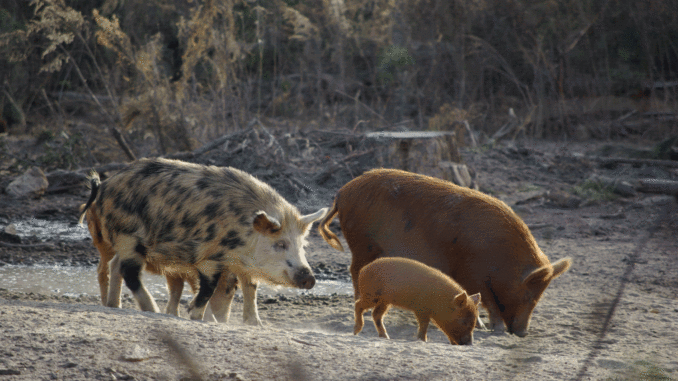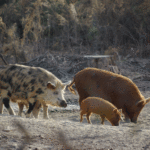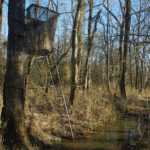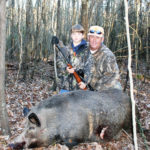
Wild hog populations are exploding across the country, and South Carolina is no exception. Here are a few tips to help you bag your boar.
With hog-hunting regulations growing less stringent and the animals becoming more widespread, you’d think hunting them would be getting easier, but that’s not the case. In fact, the highly intelligent wild porkers seem to be staying one hoof ahead of us.
Cowden Plantation, home of Jarrett Custom Rifles, covers 10,000 acres along the Savannah River, a stone’s throw from the “bomb plant.” It’s a Shangri-la for deer and turkey, but it also provides the ideal setting for wild hogs.
Fifteen years ago, Kenny Jarrett and his son, Jay, had a bag limit on wild hogs and discouraged the killing of sows in order to encourage population growth.
Today, it’s a different story.
Along with working with his dad in the Jarrett custom gun shop, Jay Jarrett (803-471-3616) farms cotton and soybeans and runs a hunt club on the plantation. For him, hogs are a mixed blessing. Although they destroy crops, the paying deer hunters enjoy having the possibility of a mixed bag. And a “most wild hogs killed” contest doesn’t hurt, either.
Jarrett said hunters kill a good many hogs over corn late in the evening during deer season, but hogs have learned that moving under cover of darkness is a lot safer.
That’s why, if it’s legal where you are, hunting at night may give you the best odds for success. According to Jarrett, the laws have changed to make it easier to kill hogs after dark.
For his hunters who hunt during the day, corn is the main ingredient for bringing hogs out of the deep swamp and into the open. He recommends against putting out too many corn piles, as the animals will tend to move from one to the other, and it becomes an even bigger game of cat and mouse.
“We try to put the corn in just one area,” he said, “and that way we keep them there. That’s historically worked pretty well for us. But what I’ve seen in the last couple of years is the hogs are getting a lot more nocturnal. Because they know that feed’s there, so they can come out at night and eat the feed. You can put it out right at dark, and it’s completely gone in the morning. They’re a lot harder to hem up then they used to be.”
He said that if you’re putting out corn and not drawing hogs, then there must be another, more-favored food source available, such as acorns. And just as the pigs will spend all night on a corn pile, they’ll stay under an oak until every acorn has been vacuumed up.
According to Jarrett, the pigs are definitely adjusting their behavior to avoid hunters.
“I can remember 20 years ago, you could drive around the place in the middle of the day, and it was nothing to see 20 or 30 in the road. You just don’t see that anymore.”
While he attributes a lot of the cautious night travel of the hogs to hunting pressure, he said they still kill plenty of pigs.
“When you put out corn for the first time in August,” he said, “when you haven’t put any out all summer, they tend to go crazy at that point.
“But I think the best bet is to find you a spot where the hogs are, and keep the bait there. Whether it’s a feeder or whatever, just keep the feed there. Because if they ever leave, you’ve got to wait until they come back around.”
Jarrett said a lot of people put corn out once a week, and that just won’t keep them there because they’re going to finish it up and move on.
“The key there,” he said, “is to get a feeder of some description, or keep going back and corning up every few days… as often as possible.”
Hugh Walters owns Deerfield Plantation near St. George. With more than 5 miles of Edisto River shoreline, his Lowcountry property offers wild hogs the diversity they look for: deep swamps, areas of high, dry ground, abundant mast, a river system to travel and cultivated land to raid — just like the conditions at Cowden. In order to keep them around for his hunters, Walters adds one other magic ingredient. You probably guessed it: shelled corn.
Walters (843-563-7927) said he tries to keep corn out for the hogs all year, except during turkey season. In his part of the state, baiting with corn for deer is legal.
“Normally, the hogs will come to the corn piles real good, except during the fall. This time of year, they’re in the bottoms eating acorns,” Walters said. “It’s amazing to see how much rooting is going on down in the swamps right now.”
Walters’ favorite time to hunt hogs is December through February. By then, natural foods have been eaten, farmers have harvested most of their beans and corn and the opportunistic hogs find a pile of shelled corn irresistible.
“We see a good many of them rooting around in the food plots during that time” he said. “They’re coming to the corn piles, too. I imagine that’s when we kill most of our hogs.
“We don’t seem to see as many as we (did) at one time,” Walters said. “You just didn’t have that many people hunting them 15 years ago, but there’s been a lot of hunting and trapping recently.”
Walters smiles when he says he has a love-hate thing for the hogs.
“I like them because they give us something to hunt during the offseason, but they are destructive. They tear your roads up, your dikes, dams… so we’re constantly trying to repair the damages they cause.
“But on the other side of it, people love to come hunt them. We get a lot of local people as well from out-of-state who love to do it. It’s kind of like giving people another hunting season —another big-game animal to hunt, even though the state doesn’t consider them a game animal.”
For those hunting hogs where baiting is legal, Walters recommends keeping the “golden attractant” available for the critters.
“We use a couple of other things…. I don’t want to give away all my secrets… but corn is the primary thing. It seems to be the cheapest thing to use. You can buy a lot of attractants, but all that costs you two or three times as much as corn,” said Walters, who prefers using shelled corn, although the cob corn lasts longer. Again, it’s a matter of cost.
One hog-baiting trick involves a posthole digger and a bag of corn. By filling a foot-deep hole with shelled corn and lightly covering it with dirt, the hogs have to work harder to eat it. Instead of having to keep replacing the corn pile each day, you have a bait that might last up to a week.
Regardless of whether you used corn piles, corn feeders, corn holes or spot-and-stalk, keep in mind the hog has an awesome sniffer to make up for his nearsightedness.






Be the first to comment